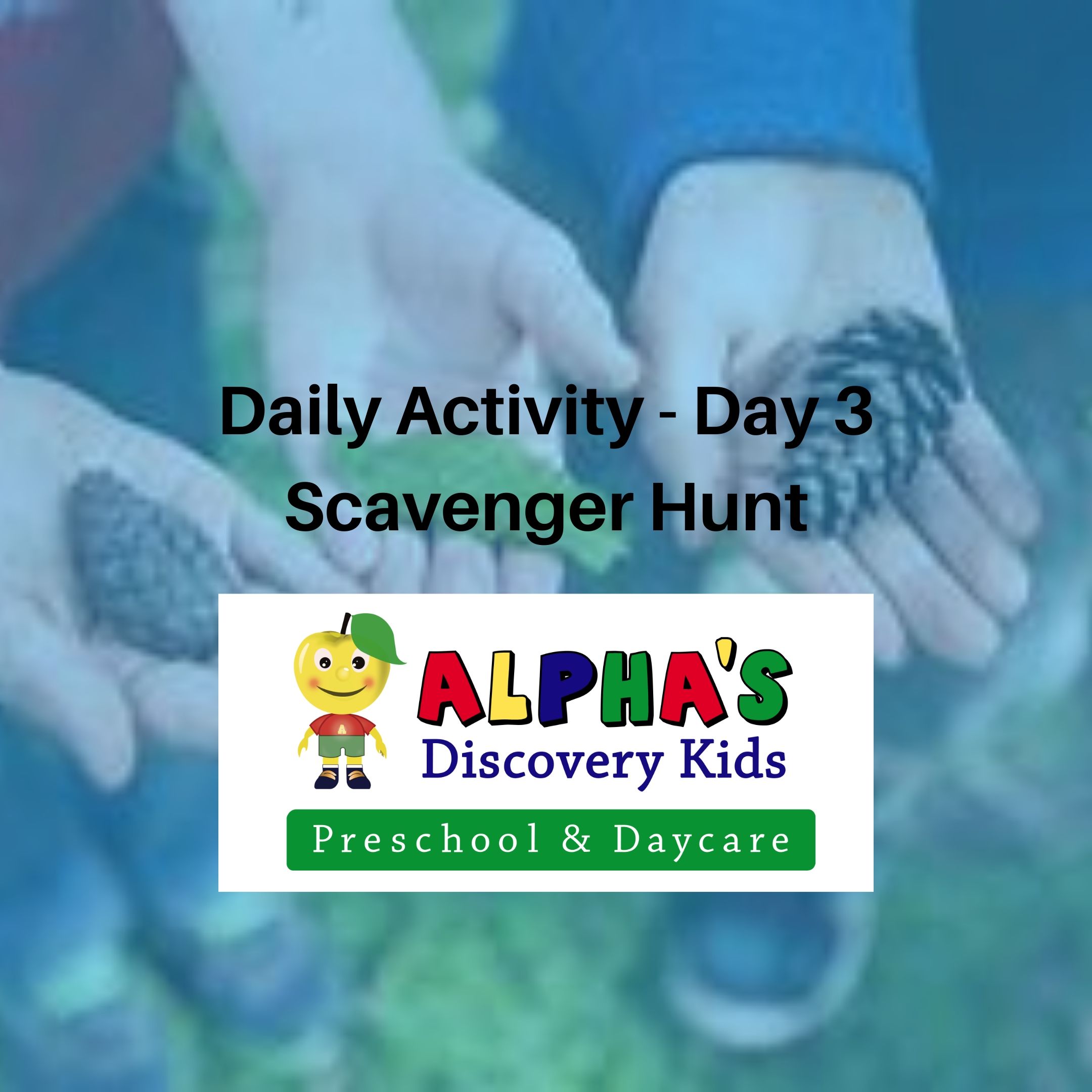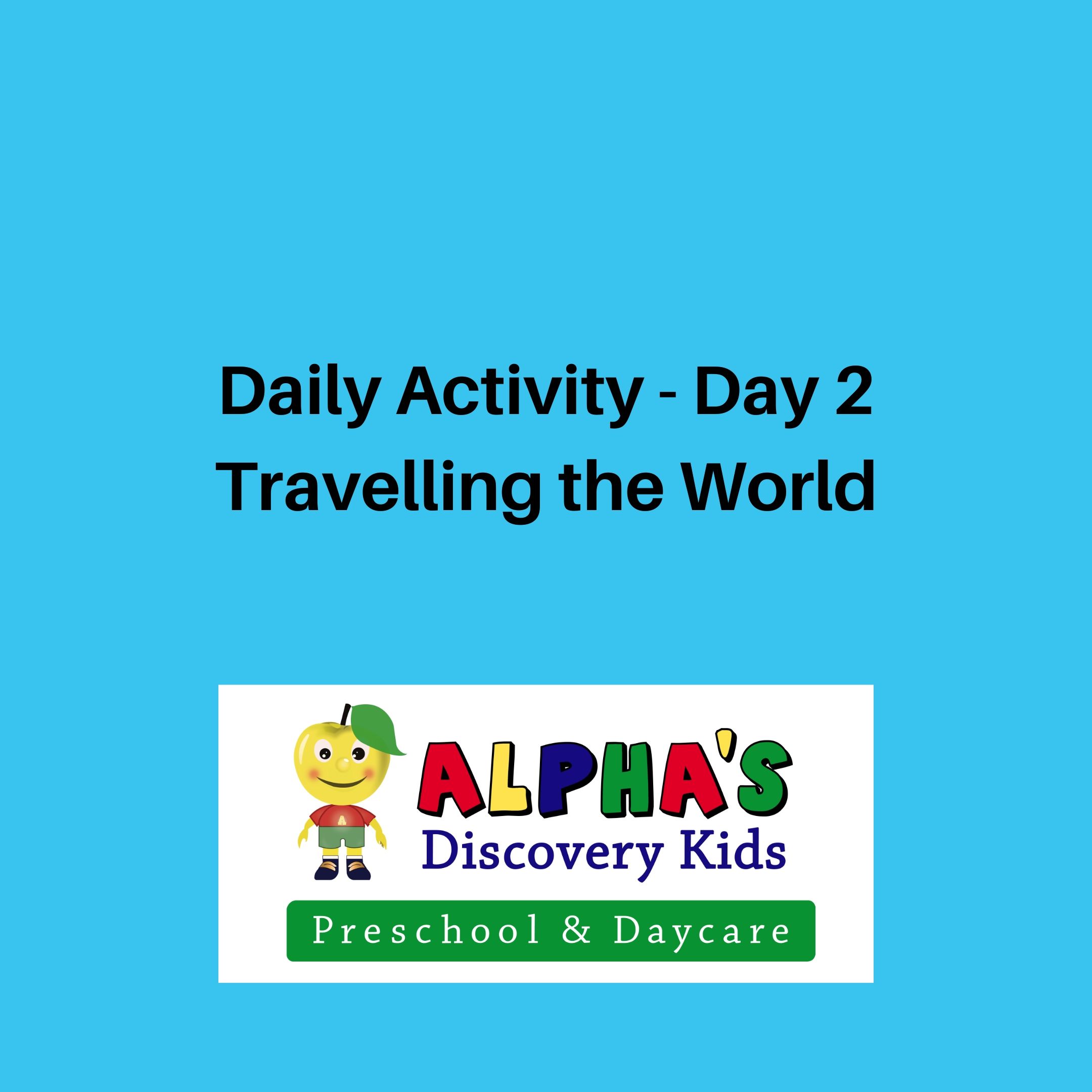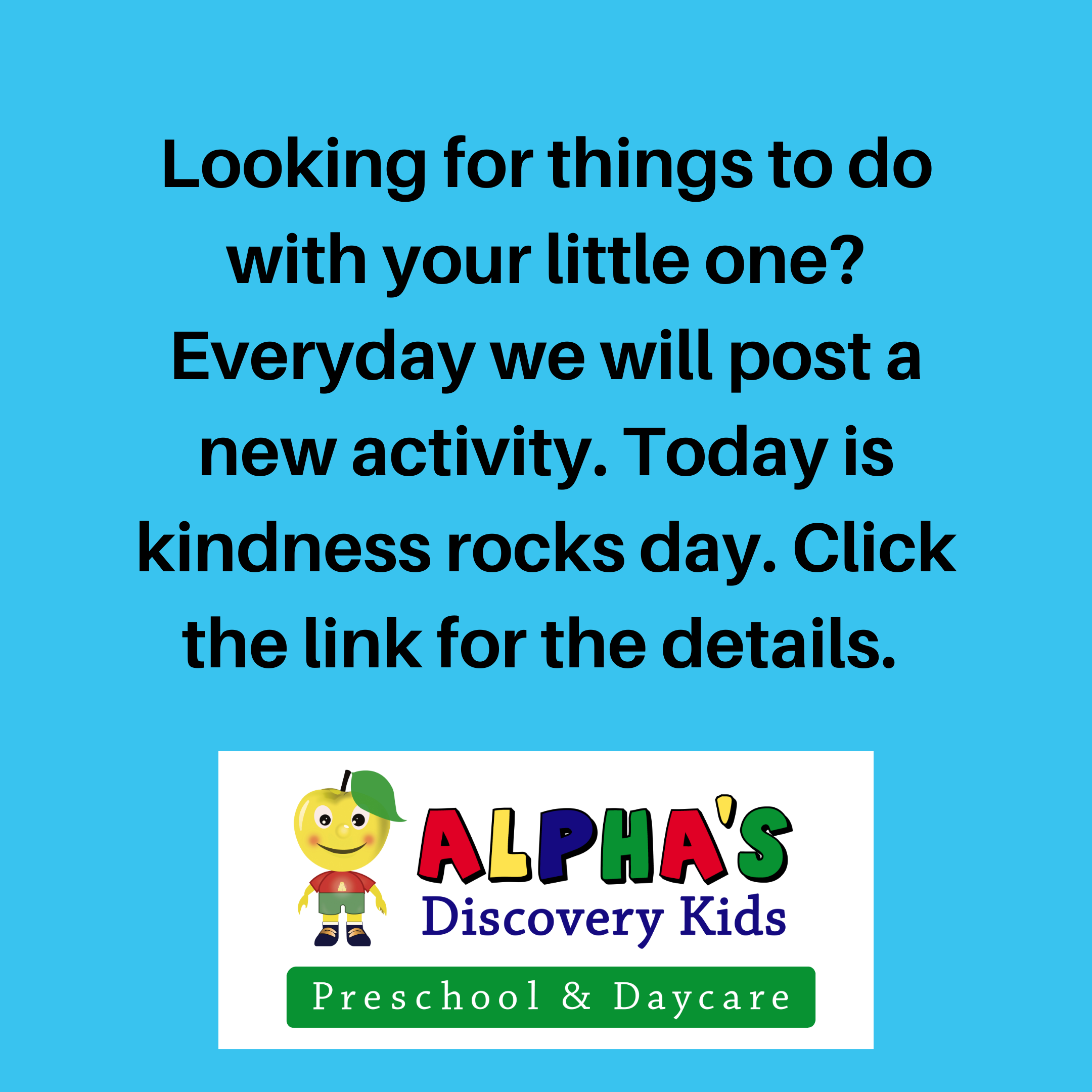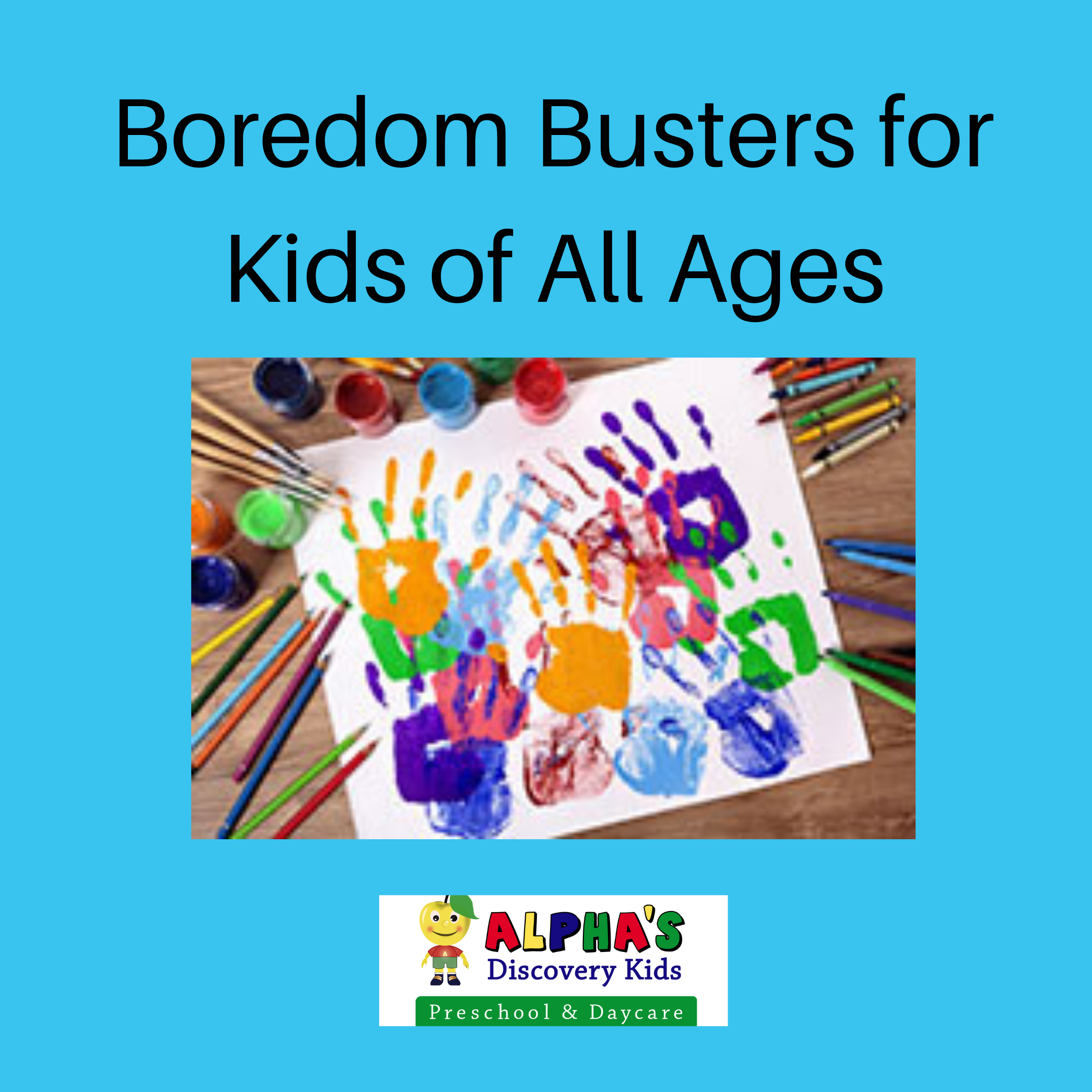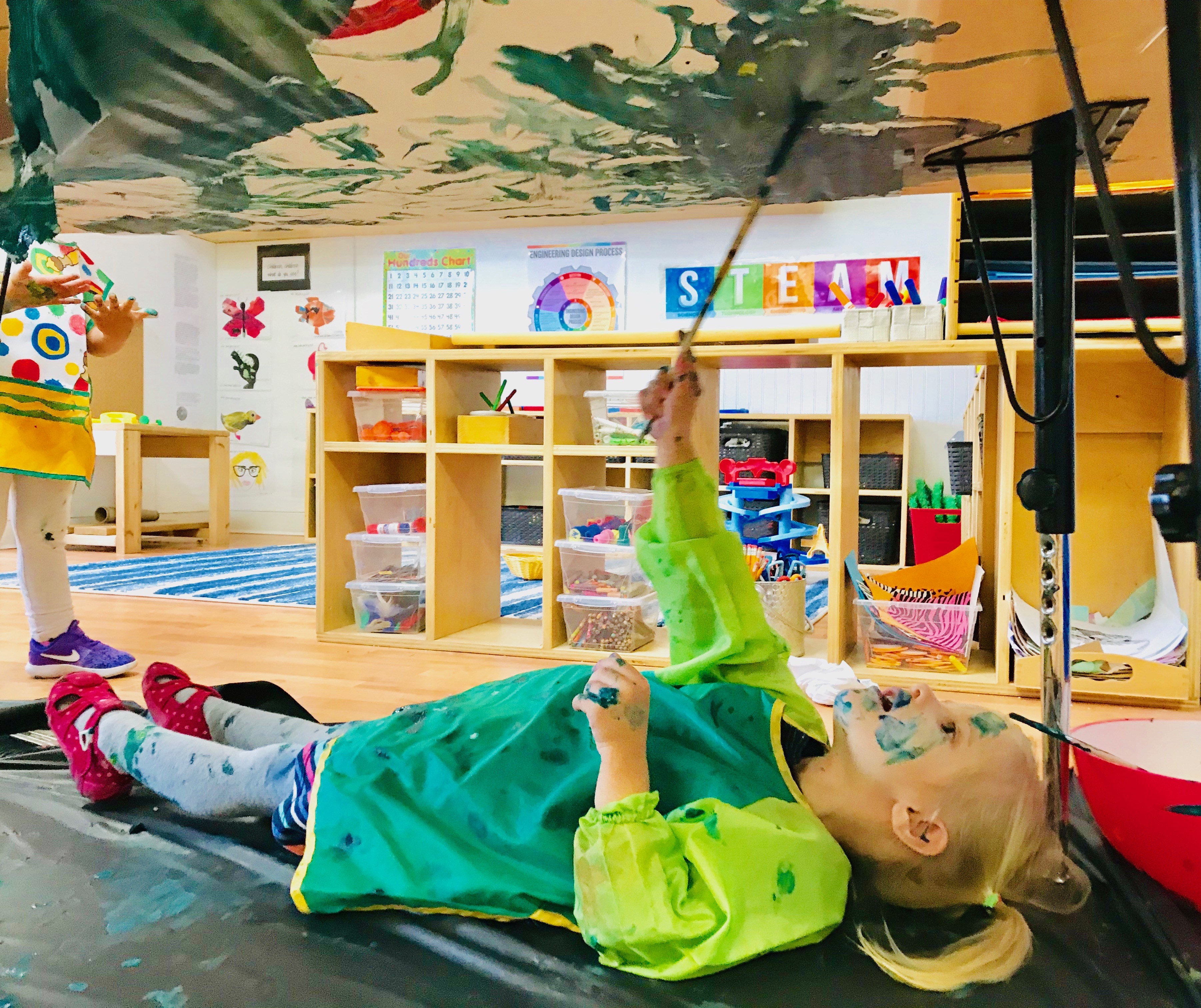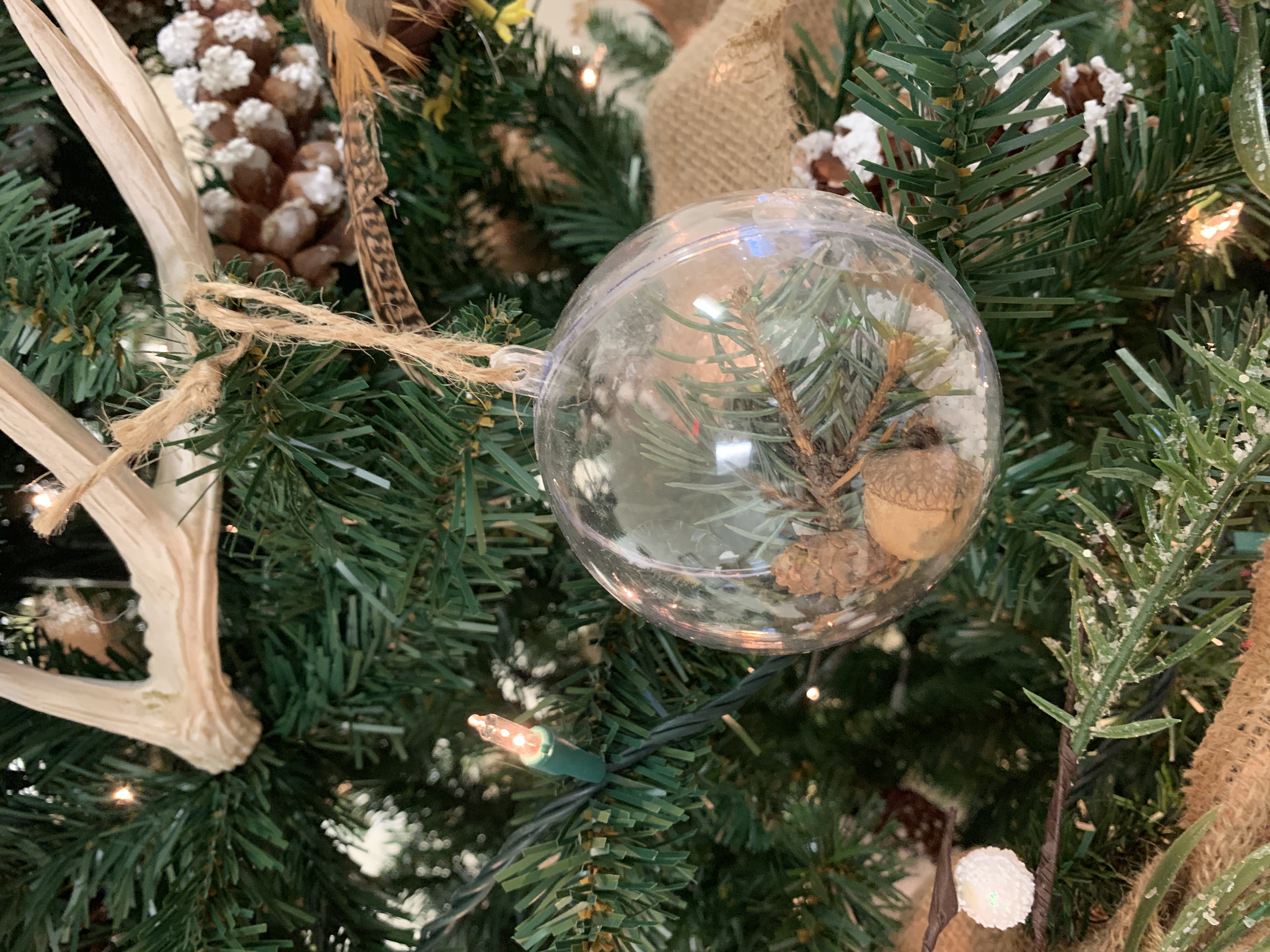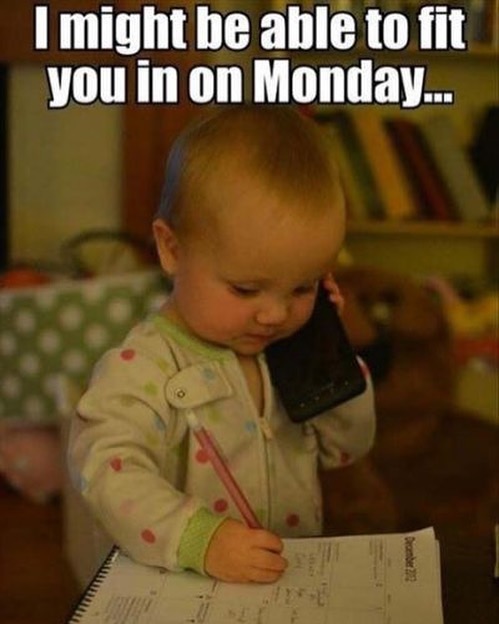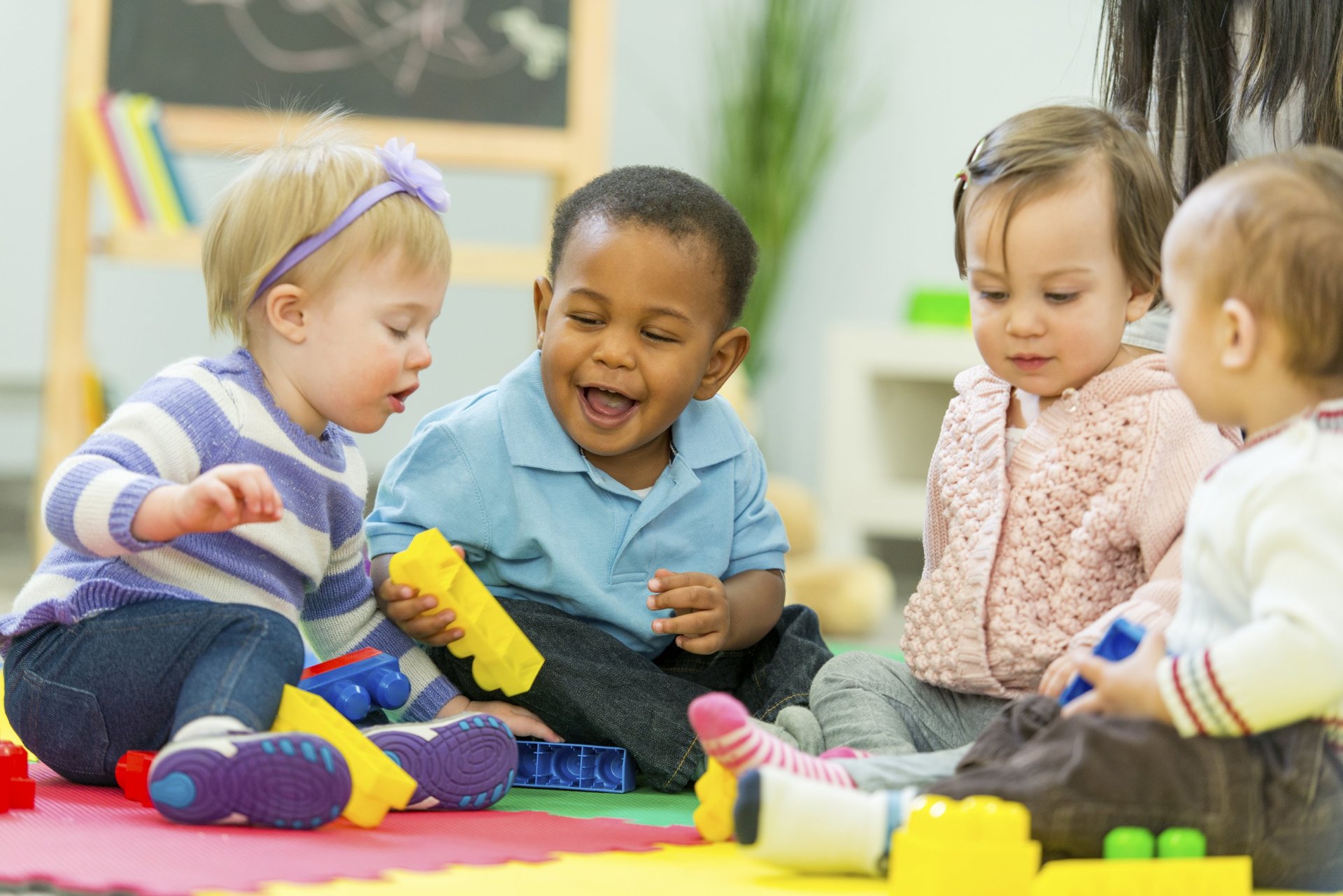Daily Activity for Kids – Day 3 – Scavenger Hunt
Daily Activity for Kids – Day 3 – Scavenger Hunt
During this COVID-19 pandemic, many parents are home with their children and looking for things to do. This is a daily post to give you ideas of fun things to do. It comes from activities that we implement at our daycare centre using our Four Pillars of Learning curriculum. Since we are closed during this time, we are sharing the activity for you to implement in your own home. Enjoy!
Today’s Activity: Scavenger Hunt
With spring weather approaching, why not get outside for some fun, exercise and a break from the indoors and what better way to do that then with a scavenger hunt.
Step 1: Prepare your scavenger hunt list. It can include the following items.
- Something colourful (you can also name a certain favourite colour)
- A pine cone
- An acorn
- Something smooth
- Something rough
- Two kinds of leaves
- Two kinds of sticks
- Something bumpy
- A flat rock
- Something fuzzy
- Something pretty
- A chewed leaf
- A flower or petal
- A piece of litter
- Something you think is a treasure
Step 2: Plan where you will go. Will it be a local park, a hiking trail, or even your own backyard? You can decide to collect each item and bring it home or you can take pictures and make a collage of your journey to remember it.
Step 3: You can separate into teams to make it a fun challenge (make it competitive) or work together as a family to complete the list together.
Step 4: Once you have all the items (either collected or pictures), take them back home and create a fun story with the family using the items you have. E.g. There once was a beautiful (insert your something colourful) who became friends with a pine cone named (name your pine cone) and then keep going until you reach the end of your story. This builds language and literacy skills.
Step 5: Make a collage picture of all the items you collected. You can glue the actual items on the paper or pictures of them to your collage picture. This will be a lovely keepsake.
This is something that you can do daily or weekly. You can change your list each time. Every child loves a scavenger hunt!
This daily kids activity incorporates many learning areas based on our Four Pillars of Learning curriculum including: language and literacy, science (nature), art and physical activity.
Daily Kids Activity – Day 2 – Travelling the World
Daily Kids Activity – Day 2 – Travelling the World
During this COVID-19 pandemic, many parents are home with their children and looking for things to do. This is a daily post to give you ideas of fun things to do. It comes from activities that we implement at our daycare centre using our Four Pillars of Learning curriculum. Since we are closed during this time, we are sharing the activity for you to implement in your own home. Enjoy!
Today’s Kids Activity-Travelling the world
Children and even adults of all ages love to imagine and pretend. Where would you go if money wasn’t an option? What would you see? What experiences would you have? In today’s activity, you get to travel anywhere in the world from the comfort of your own home!
Step 1: Grab a computer, tablet or phone and sit down with your child to visit these sites together for great travel ideas. These kid-friendly websites are sure to give you some ideas for places you would like to visit.
www.kids.nationalgeographic.com
https://outdoorfamiliesonline.com/
https://www.familyadventureproject.org/
Step 2: Have a discussion with your child about the places you see online and have your child pick a place they want to visit. This is where you will go today.
Step 3: Find a space in your home to build a fort. Use sheets, blankets, furniture, pillows, anything that you have accessible to make your fort resemble where you are headed. Think about what you will need in your new place based on climate, such as blankets if it is a cold place.
Step 4: While sitting in your fort, use the laptop/tablet/phone to find out information about the place you are visiting. Talk about the animals who live there, food they eat, local temperatures etc. The websites listed above are a great start. You can even find videos that will give you visuals of the place you are visiting and have them playing in the background.
Step 5: Extend the learning by adding on more activities throughout the day. You could make a local food from the area (e.g. Pizza for Italy, Tacos for Mexico etc.) Take the music from the place you have visited and create a music video including all the family. Make it fun and get moving. Grab some paint or other creative materials and make a picture of something you saw on your visit. It could be the food, the village, the ocean, etc.
This is something that you can do daily. Plan a list of home vacations you will take over the next few days. This is a fun and creative way to educate your children and have fun in the process. Let your imagination go wild! Your kids will love it!
This daily kids activity incorporates many learning areas based on our Four Pillars of Learning curriculum including: STEAM science (cooking), technology (computers), engineering (building), art and language.
Daily Activity for Kids – Day 1 – Kindness Rocks
Daily Activity for Kids – Day 1 – Kindness Rocks
During this COVID-19 pandemic, many parents are home with their children and looking for things to do. This is a daily post to give you ideas of fun things to do. It comes from activities that we implement at our daycare centre. Since we are closed during this time, we are sharing the activity for you to implement in your own home. Enjoy!
Today’s Activity: Kindness Rocks
Step 1: Go for a walk in the neighborhood and collect rocks of all sizes. Try to find some as big as the size of a child’s hand.
Step 2: Put out some paint in various colours and paint the rocks. We encourage both adults and children to participate and paint their own rocks. You can use a paint brush or a toothbrush to make it easier to paint smaller rocks. Let them dry completely.
Step 3: Get a permanent marker and write a kind message on the rock. Ask your child what they would like to say to help someone have a great day. This helps children develop empathy.
Step 4: Go for another walk in the neighborhood and leave the rocks out for other people to find them.
Step 5: This can extend beyond Day 1. Go back to the places you left the rocks and see if they are gone. Make it like a scavenger hunt. If they are still there, you can move them to another spot.
This activity can be repeated and if enough people in the community are participating, you could also go out and find other people’s rocks. This could have a huge multiplier effect. Share this activity with a friend and you can also go out and find each other’s rocks. Most of all, have fun and know that you may brighten someone’s day!
Check out our boredom busters page for more ideas.
Boredom Busters for Kids of all Ages
Boredom Busters for Kids of all Ages
In light of the social distancing protocol and closure of schools and events due to the COVID pandemic, we thought we would provide you with some safe alternatives to prevent boredom and still allow families to have some outdoor fun as well. These are some safe activities to do with families during this time.
1. Go for a walk. On a walk you can admire everything that is still blooming and alive outside. Take a breath of fresh air, count the number of dogs you see, count any flowers you can see blooming, or just enjoy the sunshine. If it’s raining, take an umbrella and rubber boots and still get out there.
2. Go on a hike. Being out in the woods is a safe place to be and still follows the protocol of social distancing. Collect sticks, pinecones, other items that can be used for activities inside the house. Again you can look for squirrels, climb trees and just enjoy the outdoors. Be sure to stay away from flooded rivers and lakes that may be high in the early Spring.
3. Make spring cleaning a fun game. Have your child(ren) clean out old clothes, toys and other items they can donate to a local charity that collects these items. Research the charity online with your child so they can see where the donations will go. A visual helps them understand what they are doing and why.
4. This a great time for family board games and puzzles. Grab a board game you haven’t played for a while. Sit down, no tv on and enjoy the time together. Work on a puzzle together as a project or make a LEGO structure.
5. If you want to help your child with educational activities while they are off school, visit the page www.kidsactivitiesblog.com – they provide enough activities to keep the kids busy for the entire time they are off.
6. Have a lip sync battle at home. Turn on your favourite music and create fun memories by singing and dancing together.
7. Make a movie. Use a phone or tablet to record your movie. Put on costumes and make it up as you go. Have fun with it and involve the whole family in the movie. Let everyone take turns recording and performing in the movie. You will have a great keepsake to look back upon.
8. Make food together. Whether baking banana bread or preparing a special tea party snack, cooking can involve the whole family with everyone participating.
9. Make a family art project and get creative. Everyone can use their own special talents to contribute to it. Some may like making designs on a computer while another may love painting. Try to incorporate everyone’s contribution into one project and make it a family keepsake. Art is great for reducing stress when there are no expectations and everyone does what they like.
10. Make a bird feeder and watch the birds come to enjoy your creation. There are many bird feeder recipes online to choose from.
While these are only a few activities to keep you and your family busy, try remembering back to your childhood and the things that you loved doing. This is the time to shut off electronics and get back to the good things in life. Enjoy it!
There are still things that are not cancelled in this trying time so enjoy the good things: getting outdoors, music, family, reading, singing, laughing and of course, hope.
E is for Engineering
At Alpha’s Discovery Kids Preschool and Daycare, we understand the importance of educating children using a wholistic approach. Engineering is a key component of our STEAM (Science, Technology, Engineering, Art and Math) program which is one of our four pillars of learning. You may be wondering how we teach young children engineering skills. This may seem like an abstract concept that young children wouldn’t understand. So first, let’s define engineering and then discuss how we teach those skills to young children.
Engineering is the application of scientific knowledge to solving problems in the real world. Therefore, people use engineering skills to solve problems, which may include learning how things work and building things that we will solve problems in our daily life. So, if you look at it that way, young children are constantly in the process of engineering. They are so inquisitive and they are constantly trying to figure out how things work. It starts with simple tasks, like opening a closed cupboard door or moving a car up and down a ramp. Every activity that they are participating in, is giving them the opportunity to problem solve. One day, these simple little tasks will teach them to solve bigger problems. Teaching children how to think creatively and learning to solve problems prepares them for the future.
Engineering is the process by which young children discover how the things in their world are built and how they work. Whether it is building a block tower, or it is exploring a simple pendulum, engineering is a natural part of everyday, early learning.
Now that we understand what engineering is and how it relates to young children, how do we foster the development of engineering skills. Exploration is a major component when it comes to engineering, so we need to give children opportunities to explore. The ability to freely explore something is important while avoiding too many rules and instructions. This will help the children to solve a problem creatively and lead to understanding and insight.
Another way to foster engineering skills is to let the children play. As parents and educators, we can be over-protective of this generation of children as we try to eliminate any area of risk for them. We fear the slide is too high, that they shouldn’t climb up it. We begin to instill fear in them that isn’t there. Let them play in mud and make mud pies, let them play with sticks and blocks and shovels. Let them be kids and explore. Playing in mud won’t hurt them, it only creates opportunities to problem-solve, create and imagine.
At Alpha’s Discovery Kids, we provide planned activities to the children every day that builds on engineering skills. We provide specific materials to let them build and engineer with. It is important to have a plan and purpose, as well as have the freedom to play and explore. It is okay to create challenges for young children to engineer and build.
Here’s some things you can try at home. Give your child a basket of blocks and challenge them to see how high they can create a tower. Gather rocks outside and create a rock tower. Provide different shapes and sizes of these materials so that they learn what order to place the items in, from biggest to smallest, from fattest to thinnest. It is important to allow the space needed for when the tower does fall, or they make it too tall or too wide.
Provide children with random material in a basket and see what they can build and create. You can put paper, glue, scissors, random craft supplies and let them create and imagine. It is important to ask thought provoking questions along the way. The key is to have one-on-one conversation with your child throughout the engineering process.
Visit our curriculum page for more information about how we incorporate engineering into our four pillars of learning through STEAM curriculum. We have truly developed an exceptional program that focuses on the child as a whole. We believe that language, literacy, STEAM and mindfulness can provide children a path for continuous growth.
A is for Art in STEAM
At Alpha’s Discovery Kids, we understand the importance of educating children using a wholistic approach. Art is a key component of our STEAM (Science, Technology, Engineering, Art and Math) program which is one of our four pillars of learning. We believe that incorporating art into everyday learning is essential. It can encompass science, math, language, engineering and more. Art builds creative skills which are essential to success in all other subject areas. A good scientist, mathematician or engineer must also have creative skills. Art allows children to explore and learn, be creative and use their imagination.
It is important for educators and parents to foster this learning. Art projects can be as simple as a crayon and a piece of paper or as complex as making a nature scene from cutting out pictures and gluing them to paper.
Preschoolers and toddlers do not care about the finished product. They love the creating process, from smearing paint with their fingers on paper to gluing pom poms to a box. It can be hard for parents and educators alike, to sit back and allow the process to happen. We naturally want the sun in the sky and the tree on the ground and not the reverse.
As kids manipulate a paintbrush, their fine motor skills improve. By counting pieces and colors, they learn the basics of math. When children experiment with materials, they dabble in science. Most important perhaps, when kids feel good while they are creating, art helps boost self- confidence. And children who feel able to experiment and to make mistakes feel free to invent new ways of thinking, which extends their learning well beyond the art project.
Art helps children develop their fine motor skills by grasping a pencil or crayon, a paintbrush or chalk. This developing skill will help your child to button their coat or to begin writing. Art activates the critical thinking part of the brain. Children begin to understand that their actions have consequences; if I push harder with the crayon, the colour gets darker. It teaches children to match concepts, like size, shape, they can make comparisons to other items they are using.
What can you do as a parent to build these skills? Having children describe their artwork to you is a great form of communication. It allows them to use their language skills as they process what they have made. You can assist them in learning new words as you ask them questions about their project. Giving children a creative outlet allows them to relieve stress and work through things happening in their lives. Encouraging children to be artistic and express themselves helps facilitate learning and self-esteem.
It is hard as adults not to draw for our children. Instead of drawing your own version of a tree besides theirs, try copying them. Draw the same picture as they are. Make big scribbles, draw big lines and small lines. If children are focused on what the adult is drawing, it takes away from their artwork.
Think about this, if you were at an event and you were told what to wear, how to sit, what to drink, what to eat and how to dance, would it be enjoyable? Ensure that you are giving children choices. Let them decide the materials they want and how and when they want to use them. You have to be prepared for a mess. Have the proper area available and let your child explore. It is okay if they peel the paper off the crayon and roll it along the paper. It’s okay if you provided a paintbrush and they use their fingers. Always focus on the process and not the product. Let them know they are doing a great job and that you love their artwork. Your voice
will always be your child’s inner voice.
Art is about letting it go. As long as your child is safe (i.e. Not running with scissors), let them
explore. This may involve letting them sharpen the pencil crayon for 15 minutes or 15 times
during a 20-minute experience, but children learn best through play and exploration.
Visit our curriculum page for more information about how we incorporate art into our four pillars of learning through STEAM curriculum. We have truly developed an exceptional program that focuses on the child as a whole. We believe that language, literacy, STEAM and mindfulness can provide children a path for continuous growth.
Fun holiday activities to do with your kids
Holiday fun for the whole family
Holiday fun for the whole family by Nichole Folino
Holiday fun for the whole family – At this time of year, parents spend so much time wondering what to get their children, did they buy enough presents? Will they like what we got them? We spend countless days asking them for a list of what they want, only to have to divide it amongst family members.
I can tell you as an RECE who has worked with children from 0 to 12, that it isn’t the presents the kids talk about all year. Yes, they may tell us some of the gifts they got but for the most part, it is of the time they spent with family.
They tell us stories of how grandpa fell asleep after dinner and was snoring, they tell us stories of waking up as a family and having breakfast together, they talk about going to the movies, making crafts and the quality time spent together.
Here are some great and easy ideas that you can do as a family over the holidays.
1. Family handprint Christmas tree
a. Green construction paper for the hands
b. Brown construction paper for the tree base
c. Yellow construction paper for the star
Trace everyone’s hands and cut them out. Place the largest ones on the bottom and work up to the smallest hands on top.,
2. Clear ornament balls
a. Purchase clear round ornaments that open from the dollar store
b. Place anything inside of them (glitter, pom poms, photographs, acorns, pine needles, fake
snow.
c. Hang them on the tree
3. Cinnamon stick reindeer
a. Purchase cinnamon sticks from the grocery store or bulk store
b. Glue them together in the shape of an A and then turn it upside down
c. Place eyes just under the horizontal stick (either googly eyes or you can draw them with
marker)
d. Glue a red or black pom pom on the bottom to make the nose
e. Attach a string to hand them on the tree
4. Christmas Playdough
a. 1 tablespoon cooking oil
b. Food colouring (gel is the best to use for vibrate colours)(red or green)
c. 1 cup of water
d. 2 tsp on cream of tatar
e. 1 cup of plain flour
f. 1⁄2 cup of salt
g. You could add a teaspoon of vanilla extract, gingerbread extract or peppermint extract to
give the playdough a holiday smell.
5. Santa Limbo is a great and fun game to play with the whole family. Have participants put a “Santa belly” under their shirt using a pillow. Place a limbo stick or you can use rope at a starting height. Then have everyone line up and one by one try to limbo underneath (with the Santa belly) until everyone has tried. Slightly lower the stick and have those who made it go again. Continually lower the stick until there is a winner.
The holidays are about family and making memories. Presents only last for a short time until the children move on to something else. Use this time to have fun, get closer and give them the gift that money can’t buy, your time.
Thanks For Reading Holiday Fun For The Whole Family
Thanks for reading Holiday Fun For The Whole Family. If you have any questions about Alpha’s Discovery Preschool & Daycare, in either Mississauga or Oakville, feel free to contact us at any time.
Technology in childcare: Using it wisely
Technology in childcare: Using it wisely
At a very young age children are developing a sense of initiative and creativity. They become curious about the world around them and how things work. At Alpha’s Discovery Kids Preschool and Daycare, we understand the importance of educating children in all areas to help them grow and develop.
Technology is one of the key programs that we focus on in our Four Pillars of Learning Curriculum. It is the second letter in the STEAM program. Digital technologies provide an outlet for them to demonstrate their ability to explore and learn. It is important to use developmentally appropriate interactive technology that is designed to enhance feelings of success.
Capturing photos of block buildings or artwork that children have created or videotape dramatic play to replay for children, allows them to look back on their accomplishments and re-tell stories of events that have happened in their classroom.
Technology plays a positive role in children’s development and learning. With the help of technology, teachers have access to more innovative and improved teaching methods that allow them to promote learning and create an active learning environment for children. It is very important to ensure safety when using technology with children. Teachers support their growth by following the children’s lead. For example, if the children are talking about bears, a teacher can use technology to show the children where different bears live, the types of food they eat or how much they weigh.
Children under 5 years old have been raised with technology and they are familiar with it from a very early age. Have you ever handed your child an iPad or your phone and watched them magically move through the screens with ease? Sometimes our children seem more capable of using technology then we do.
We understand why some parents may have concern about their child being introduced to technology at school when it surrounds them so much at home. We know that some parents are concerned about the negative effects of “too much screen time”. While we understand their concerns, we also know that when technology is used wisely to enhance learning, it can assist in achieving the learning goals set out by the program. Allowing technology in the classroom can encourage more opportunities for students of varying ages and abilities to engage, communicate, and explore.
It is important to understand that the goal of technology use in the classroom is to support collaborative learning environments and, therefore, enrich student’s interactions with their peers. It is important for teachers to be there to know when it is an appropriate time to introduce technology into a lesson or activity.
With technology children can reach places they may never see, the galaxy, the jungle, mars and more. They can visit all of these places in a safe environment with the support of the Early Childhood Educator. Preschoolers can take more control of their learning and expand their own horizons. They can learn about things that interest them and build on their own understandings.
Technology can also be a way to create more structure and focus in a classroom that may be busy with energetic preschoolers. Simple things like playing music in the classroom for nap time, music and movement time, yoga and relaxation can be a great way to calm a room and provide for some focused activities. Technology tools also support the ways educators measure and record development, document growth, plan activities, and share information with parents. At Alpha’s Discovery Kids, we use HiMama to communicate with parents so that they are always aware of what is going on with their child in the classroom.
It is how we use technology that makes the difference. If we use it wisely, in a positive and educational way both at home and in the classroom, we can teach children valuable skills. There is no doubt that children need to be able to use technology to be successful in the future. We think it’s important to prepare them to be successful.
We strongly believe in supporting children in all areas of their growth and development. Visit our curriculum page for more information about how we incorporate technology into our four pillars of learning through STEAM curriculum. We have truly developed an exceptional program that focuses on the child from a wholistic approach. We believe that language/literacy, STEAM, physical activity and mindfulness can provide children a path for continuous growth.
Why choose part-time daycare or preschool?
Why choose part-time daycare or preschool?
by Nichole Folino
As an early childhood educator, I see the impact that daycare or preschool has on children every day. I see them grow and develop, make friendships and become more social. I know that as a parent, it can be hard to justify sending your child to daycare or preschool when you are home with them or have family watching them. I can tell you that nothing has the same impact as the social aspects that are learned in a group environment such as daycare or preschool. It is clear to see the difference in the development of a child that has been to daycare and one that has not.
Developing social skills is very important for young children. Social interaction helps to build a child’s sense of self, and also helps children to learn what is expected of them. By playing and interacting with other children, they learn skills that will last their lifetime. If you look back to when you were younger, do you remember your childhood friends? Do you remember if they were kind or if they hurt your feelings? Most of us could easily answer yes to those questions.
During our childhood, the people that we interacted with helped to shape the adults we are today. Daycare and preschool are the beginning stages of that. Children make new friends, learn to feel accepted, learn to play cooperatively and be respectful to others. It is so important that at a young age, children learn how to build positive relationships with other children their age. Children who have poor socialization skills can struggle to develop close bonds with those around them, making it hard to build strong relationships with people later in life.
In a daycare or preschool environment, children learn how to share, take turns, set boundaries and problem-solve. Children even begin to develop empathy. They can tell when their friends are happy or sad, hurt or angry. Children begin to understand how to manage their behaviour as well as experience consequences for their behaviour. As children grow and develop, they begin to pick up on what behaviours and reactions are appropriate and which ones are not.
In addition to the many social benefits associated with being in a daycare or preschool, children at Alpha’s Discovery Kids also experience numerous other benefits including:
- Learning to follow a routine
- Structured learning environment
- “The Four Pillars of Learning” Educational curriculum designed to teach young children
- Potty-training
- Parenting tips and advice from trained early childhood educators
Childcare is a great way to begin to prepare your child for the large world that lies ahead of them. For more information about our part-time program options, visit our Programs.

